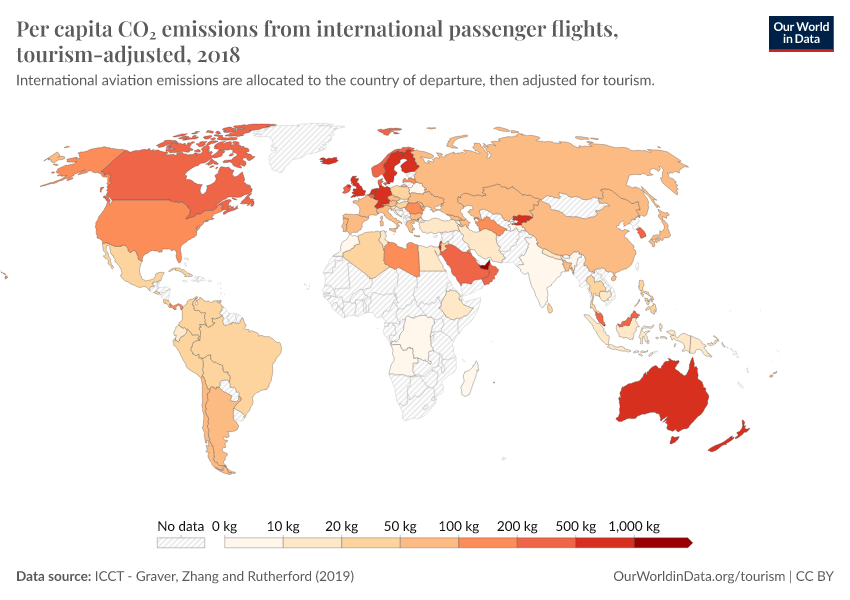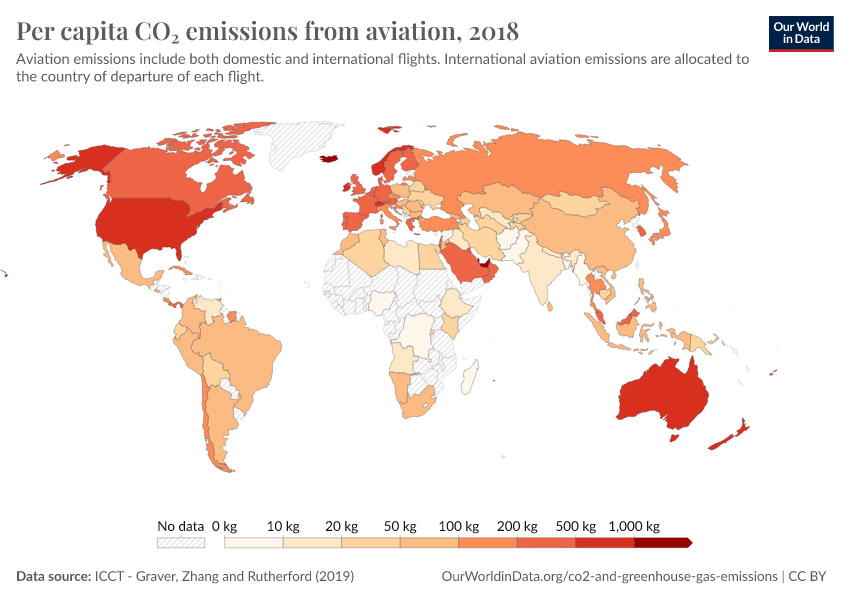Where in the world do people have the highest CO2 emissions from flying?
Globally, aviation accounts for around 2.5% of CO₂ emissions. But for many, it accounts for a much larger share.
Aviation accounts for around 2.5% of global carbon dioxide (CO2) emissions. But if you are someone who does fly, air travel will make up a much larger share of your personal carbon footprint.
The fact that aviation is relatively small for global emissions as a whole, but of large importance for individuals that fly is due to large inequalities in the world. Most people in the world do not take flights. There is no reliable global figure, but often cited estimates suggest that more than 80% of the global population have never flown.1
How do emissions from aviation vary across the world? Where do people have the highest footprint from flying?
Per capita emissions from domestic flights
The first and most straightforward comparison is to look at emissions from domestic aviation — that is, flights that depart and arrive in the same country.
This is easiest to compare because domestic aviation is counted in each country’s inventory of greenhouse gas emissions. International flights, on the other hand, are not attributed to specific countries, partly because of contention as to who should take responsibility (should it be the country of departure or arrival? What about layover flights?).
In the chart we see the average per capita emissions from domestic flights.
We see large differences across the world. In the United States, the average was around 380 kilograms per person in 2024. Emissions were also high in countries like Australia, New Zealand, Norway and Canada. Compare this with countries at the bottom of the table — many across Africa, Asia, and Eastern Europe emit less than one kilogram per person.
There are some obvious factors that explain some of these cross-country differences. Firstly, countries that are richer are more likely to have higher emissions because people can afford to fly. Second, countries that have a larger land mass may have more internal flights. We do see a correlation between land area and domestic flight emissions; in small countries, people are more likely to travel by other means, such as car or train. And third, countries that are more geographically-isolated, such as Australia and New Zealand, may have more internal travel.

Per capita emissions from international flights
Allocating emissions from international flights is more complex. International databases report these emissions separately as a category termed “bunker fuels”. The term “bunker fuel” is used to describe emissions which come from international transport — either aviation or shipping.
Because they are not counted towards any particular country these emissions are also not taken into account in the goals that are set by countries in international treaties like the Kyoto Protocol or the Paris Agreement.2
But if we wanted to allocate them to a particular country, how would we do it? Who do emissions from international flights belong to: the country that owns the airline; the country of departure; the country of arrival?
Let’s first take a look at how emissions would compare if we allocated them to the country of departure. This means, for example, that emissions from any flight that departs from Spain are counted towards Spain’s total. In the chart here, we see international aviation emissions in per capita terms.

Per capita emissions from international flights — adjusted for tourism
The above allocation of international aviation emissions to the country of departure raises some issues. It is not an accurate reflection of the local population of countries that rely a lot on tourism, for example. Most of the departing flights from these countries are carrying visitors rather than locals.
One way to correct for this is to adjust these figures for the ratio of inbound to outbound travelers. This attempts to distinguish between locals traveling abroad and foreign visitors traveling to that country on the same flight.3 For example, if we calculated that Spain had 50% more incoming than outgoing travelers, we would reduce its per capita footprint from flying by 50%. If the UK had 75% more outgoing travelers than incoming, we’d increase its footprint by 75%.
How does this affect per capita emissions from international flights? The adjusted figures are shown in the chart. Unfortunately, data is not available for all countries.
As we would expect, countries which are tourist hotspots see the largest change. Portugal’s emissions, for example, fall from more than 300 to just 67 kilograms per person. Portuguese locals are responsible for much fewer travel emissions than outgoing tourists. Spanish emissions fall by a similar amount.
On the other hand, countries where the locals travel elsewhere see a large increase.

Per capita emissions from domestic and international flights
Let’s combine per capita emissions from domestic and international travel to compare the total footprint from flying.
Not that due to data availability from the OECD, this combines air travel emissions without using the tourism-adjustment. Keep this in mind as it inflates the numbers for tourism-heavy countries.
Again, the large differences across the world become very clear.
In many countries, most people do not fly at all. The average in India was just 17 kilograms per person in 2024; this is much, much less than even a short-haul flight, which confirms that most people did not take a flight.
In fact, we can compare just the aviation emissions for the top countries to the total carbon footprint of citizens elsewhere. The average from the United Arab Emirates was 2300 kilograms of CO2. This is more than the total CO2 footprint of the average Indian (including everything from electricity to road transport, heating, and industry). Or, to take a more extreme example, around 20 times the total footprint of the average Nigerien, Ugandan, or Ethiopian, who have per capita emissions of around 100 kilograms.
This again emphasizes the large difference between the global average and the individual emissions of people who fly. Aviation contributes a few percent of total CO2 emissions each year. Yet from the perspective of the individual, flying is often one of the largest chunks of our carbon footprint. The average rich person emits tonnes of CO2 from flying each year — this is equivalent to the total carbon footprint of tens or hundreds of people in many countries of the world.

Endnotes
There is no global database available on who in the world flies each year. Passenger information is maintained by private airlines. Therefore, deriving estimates of this exact percentage is challenging. The most-cited estimate I’ve seen on this is that around 80% of the world's population has never flown. This figure seems to circle back to a quoted estimate from the Boeing CEO.
Even in some of the world’s richest countries, a large share of the population does not fly frequently. Gallup survey data from the United States suggests that in 2015, half of the population did not take a flight. Survey data from the UK provides similar estimates: 46% had not flown in the previous year.
Larsson, J., Kamb, A., Nässén, J., & Åkerman, J. (2018). Measuring greenhouse gas emissions from international air travel of a country’s residents methodological development and application for Sweden. Environmental Impact Assessment Review, 72, 137-144.
A country with a ratio greater than one will have more incoming travelers than outgoing locals i.e. they are more of a hotspot for tourism.
Cite this work
Our articles and data visualizations rely on work from many different people and organizations. When citing this article, please also cite the underlying data sources. This article can be cited as:
Hannah Ritchie (2020) - “Where in the world do people have the highest CO2 emissions from flying?” Published online at OurWorldinData.org. Retrieved from: 'https://archive.ourworldindata.org/20251125-173858/carbon-footprint-flying.html' [Online Resource] (archived on November 25, 2025).BibTeX citation
@article{owid-carbon-footprint-flying,
author = {Hannah Ritchie},
title = {Where in the world do people have the highest CO2 emissions from flying?},
journal = {Our World in Data},
year = {2020},
note = {https://archive.ourworldindata.org/20251125-173858/carbon-footprint-flying.html}
}Reuse this work freely
All visualizations, data, and code produced by Our World in Data are completely open access under the Creative Commons BY license. You have the permission to use, distribute, and reproduce these in any medium, provided the source and authors are credited.
The data produced by third parties and made available by Our World in Data is subject to the license terms from the original third-party authors. We will always indicate the original source of the data in our documentation, so you should always check the license of any such third-party data before use and redistribution.
All of our charts can be embedded in any site.